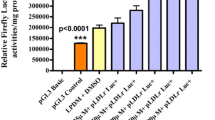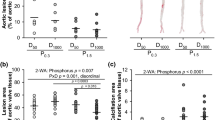Abstract
Selenium deficiency has been associated with hypercholesterolemia. Present study was aimed to determine the effect of selenium (Se) deficiency on LDL receptor (LDL-R) activity as well as mRNA expression during experimental hypercholesterolemia in SD male rats. Animals were fed Se adequate (0.2 ppm) and deficient (0.02 ppm) control diet as well as high cholesterol (2%) diet (HCD) for 1 and 2 months. LDL-R activity was measured in vivo by injecting radiolabeled LDL to rats and percent decrease in cpm with time was taken as a measure of LDL clearance and in turn LDL-R activity. LDL-R mRNA expression was studied by RT-PCR. LDL-R activity and mRNA expression decreased significantly on HCD feeding in both Se deficient and adequate diet fed rats after 2 months. In Se deficiency receptor activity and mRNA expression decreased significantly. After 2 months LDL-R activity and expression decreased in both the Se deficient groups and in Se adequate HCD fed group in comparison to 1 month data. But after 4 month there was no significant difference observed in LDL-R activity and mRNA expression in selenium deficiency as well as on HCD feeding. So the present results demonstrate that Se deficiency act synergistically with hypercholesterolemia to downregulate LDL-R activity as well as mRNA expression.
Similar content being viewed by others
References
Brown MS, Goldstein JL: How LDL-R influence cholesterol and atherosclerosis. Sci Am 251: 52–60, 1984
Rudel LL, Parks JS, Johnson FL, Babiak J: Low density lipoproteins in atherosclerosis. J Lipid Res 27: 465–473, 1986
Nomura S, Merched A, Nour E, Dieker C, Oka K, Chan L: Low-density lipoprotein receptor gene therapy using helper-dependent adenovirus produces long-term protection against atherosclerosis in a mouse model of Familial Hypercholesterolemia. Gene Ther 11: 1540–1548, 2004
Ishibashi S, Brown MS, Goldstein JL, Gerard RD, Hammer RE, Herz J: Hypercholesterolemia in low density lipoprotein receptor knockout mice and its reversal by adenovirus-mediated gene delivery. J Clin Invest 92: 883–891, 1993
Frank N, Sojka JE, Latour MA: Effect of hypothyroidism on the blood lipid response to higher dietary fat intake in mares. J Anim Sci 82: 2640–2646, 2004
Van der Wal AM, Bakker O, Wiersinga WM: The decrease of liver LDL receptor mRNA during fasting is related to the decrease in serum T3. Int J Biochem Cell Biol 30: 209–215, 1998
Chowdhury D, Parnell VA, Ojamaa K, Boxer R, Cooper R, Klein I: Usefulness of triiodothyronine (T3) treatment after surgery for complex congenital heart disease in infants and children. Am J Cardiol 84: 1107–1119, 1999
Vander Geyten S, Byamungu N, Reyns GE, Kuhn ER, Darras VM: Iodothyronine deiodinases and the control of plasma and tissue thyroid hormone levels in hyperthyroid tilapia (Oreochromis niloticus). J Endocrinol 184: 467–479, 2004
Backett GJ, Macdougall DA, Nicol F, Arthur JR: Inhibition of type-I and type-II iodothyronine deiodinase activity in rat liver, kidney and brain produced by selenium deficiency. Biochem J 259: 887–892, 1989
Dhingra S, Singh U, Bansal MP: Effect of selenium depletion and supplementation on the kinetics of type-I 5′-iodothyronine deiodinase and T3/T4 in rats. Biol Trace Ele Res 97: 95–104, 2004
Wojcicki J, Rozewicka L, Wiszniewska BB, Samochowiec L, Juzwiac S, Kadlubowska D, Tustanowski S, Juzyszyn Z: Effect of selenium and vitamin E on the development of experimental atherosclerosis in rabbits. Atherosclerosis 87: 9–16, 1991
Huttunen JK: Selenium and cardiovascular diseases—An update. Biomed Environ Sci 10: 220–226, 1997
Manar MJ, Macpherson GD, Mcardle F, Jackson MJ, Hart CA: Selenium status, kwashiorkor and congestive heart failure. Acta Paediatr 90: 950–952, 2001
Yusuf SW, Rehman Q, Casscells W: Cardiomyopathy in association with selenium deficiency: a case report. JPEN J Parenter Enteral Nutr 26: 63–66, 2002
Vijaya J, Subramanyam G, Sukhaveni V, Abdul Latheef SA, Gu G, Salam NM: Selenium levels in dilated cardiomyopathy. J Indian Med Assoc 98: 166–169, 2000
Burk RF: Production of selenium deficiency in the rat. Meth Enzymol 143: 307–313, 1987
Dhingra S, Singh U, Bansal MP: Protective role of selenium status on T3/T4 kinetics in rats under hyperlipidemia. Indian J Biochem Biophys 40: 260–264, 2003
Hasunuma R, Ogawi T, Kawaniska Y: Fluorimetric determination of selenium in nanogram amounts in biological materials using 2,3-diaminonapthalene. Anal Biochem 26: 242–245, 1982
Paglia DE, Valentine WN: Studies on the quantitative and qualitative characterization of erythrocyte glutathione peroxidase. J Lab Clin Med 70: 158–168, 1967
Lowry OH, Rosebrough NJ, Farr AL, Randall RJ: Protein measurement with Folin-phenol reagent. J Biol Chem 193: 265–275, 1951
Behne D, Kyriakopoulos A, Meinhold H, Kohrle J: Identification of type-1 iodothyronine 5′-deiodinase as a selenoenzyme. Biochem Biophys Res Commun 173: 1143–1149, 1990
Kang BPS, Mehta U, Bansal MP: Hyperlipidemia and Type-I 5′-monodeiodinase activity: Regulation by selenium supplementation. Ind J Biochem Biophys 7: 183–187, 2000
Chung BH, Segrest JP, Ray MJ, Brunzell JD, Hokanson JE, Krauss RM, Beaudrie K, Cone JT: Single vertical spin density gradient ultra centrifugation. Meth Enzymol 128: 181–209, 1986
Salahuddin H, Singh O: Radioiodination of antigens. In: Talwar GP. A Handbook of Practical Immunology, Vibas Publishing House, India, 1983, pp. 92–99
Lee O, Moon J, Chung Y: The relationship between serum selenium levels and lipid profiles in adult women. J Nutr Sci Vitaminol 49: 397–404, 2003
Kang BPS, Bansal MP, Mehta U: Selenium supplementation and diet induced hypercholesterolemia in the rat: Changes in lipid levels, malonyldialdehyde production and the nitric oxide synthase activity. Gen Physiol Biophys 17: 71–78, 1998
Huang K, Liu H, Chen Z, Xu H: Role of selenium in cytoprotection against cholesterol oxide-induced vascular damage in rats. Atherosclerosis 162: 137–144, 2002
Arthur JR, Nicol F, Backett GJ: Selenium deficiency, thyroid hormone metabolism, and thyroid hormone deiodinases. Am J Clin Nutr 57: 236–239, 1993
Berry MJ, Kates AL, Larsen PR: Thyroid hormone regulates type I deiodinase messenger RNA in rat liver. Mol Endocrinol 4: 743–748, 1990
Berry MJ, Larsen PR: The role of selenium in thyroid hormone action. Endocrinol Rev 13: 207–219, 1992.
O'Brien T, Dinneen SF, O'-Brien PC, Palumbo PJ: Hyperlipidaemia in patients with primary and secondary hypothyroidism. Mayo Clin Proc 68: 860–866, 1993
Soutar AK, Knight BL: Structure and regulation of the LDL receptor and its gene. Br Med Bull 46: 891–916, 1990
Bakker O, Hudig F, Meijssen S, Wiersinga WM: Effects of triiodothyronine and amiodarone on the promoter of the human LDL receptor gene. Biochem Biophys Res Commun 240: 517–521, 1998
Liu J, Zhang YL, Spence MJ, Vestal RE, Wallace PM, Grass DS: Liver LDL receptor mRNA expression is decreased in human ApoB/CETP double transgenic mice and is regulated by diet as well as the cytokine oncostatin M. Arteriosclerosis Throm Vasc Biol 17: 2948–2954, 1997
Goldstein JL, Brown MS: Regulation of mevalonate pathway. Nature 343: 425–431, 1990
Author information
Authors and Affiliations
Corresponding author
Rights and permissions
About this article
Cite this article
Dhingra, S., Bansal, M.P. Attenuation of LDL receptor gene expression by selenium deficiency during hypercholesterolemia. Mol Cell Biochem 282, 75–82 (2006). https://doi.org/10.1007/s11010-006-1266-1
Received:
Accepted:
Issue Date:
DOI: https://doi.org/10.1007/s11010-006-1266-1




